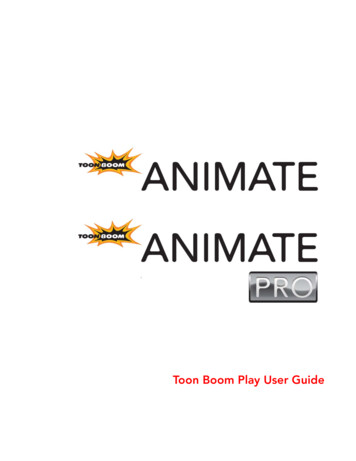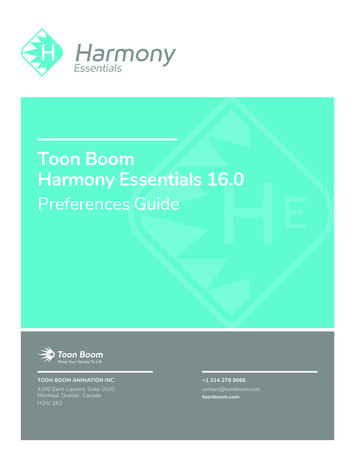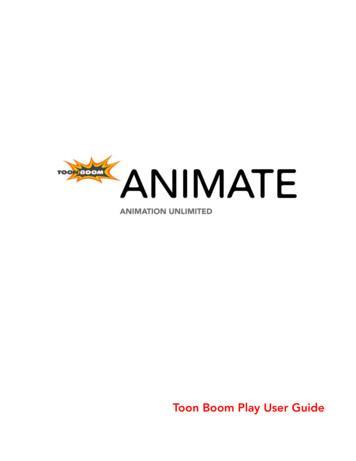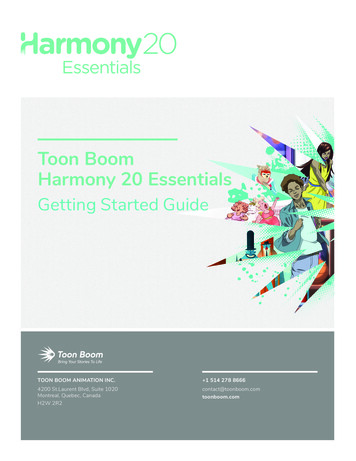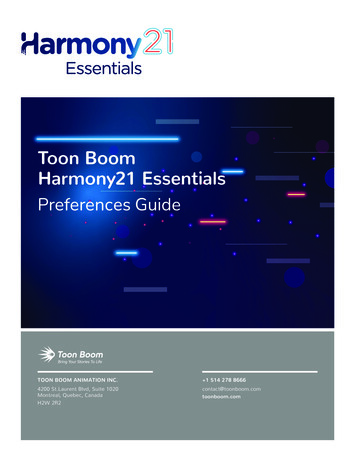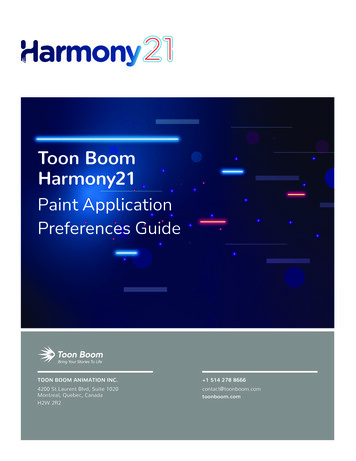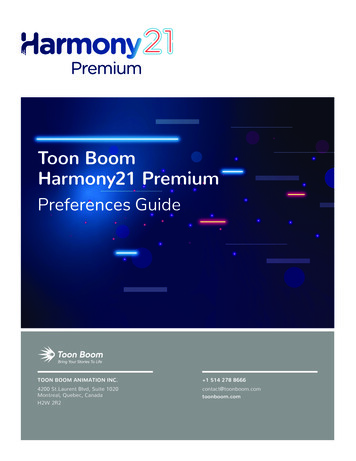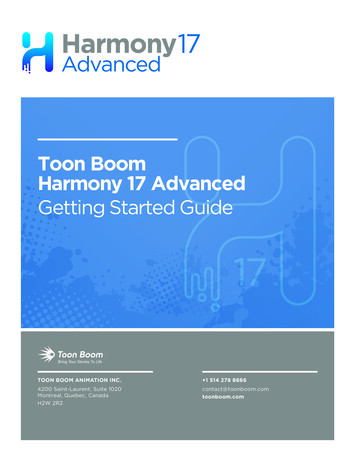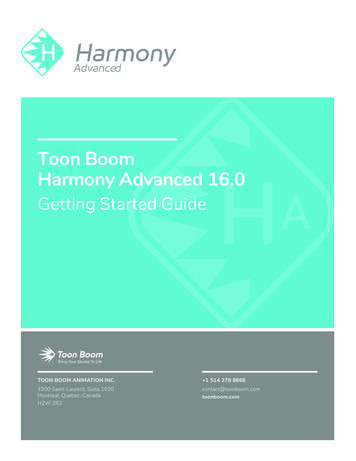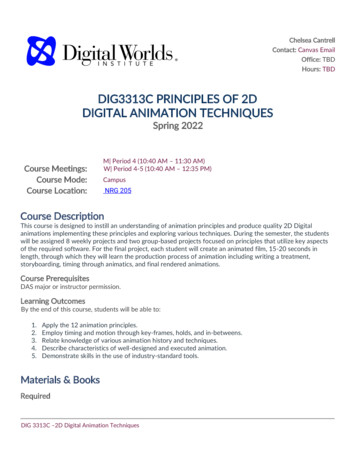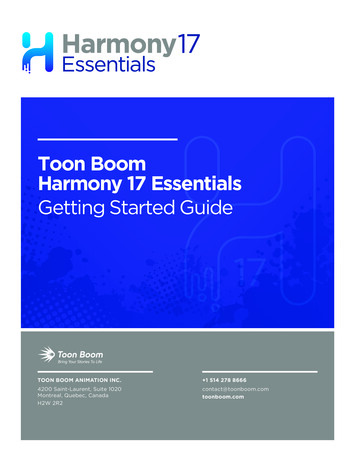
Transcription
Toon BoomHarmony 17 EssentialsGetting Started GuideTOON BOOM ANIMATION INC. 1 514 278 86664200 Saint-Laurent, Suite 1020Montreal, Quebec, CanadaH2W 2R2contact@toonboom.comtoonboom.com
Harmony 17 Essentials Getting Started GuideLegal NoticesToon Boom Animation Inc.4200 Saint-Laurent, Suite 1020Montreal, Quebec, CanadaH2W 2R2Tel: 1 514 278 8666Fax: 1 514 278 2666toonboom.comDisclaimerThe content of this document is the property of Toon Boom Animation Inc. and is copyrighted. Anyreproduction in whole or in part is strictly prohibited.The content of this document is covered by a specific limited warranty and exclusions and limit of liability underthe applicable License Agreement as supplemented by the special terms and conditions for Adobe Flash FileFormat (SWF). For details, refer to the License Agreement and to those special terms and conditions.TrademarksToon Boom is a registered trademark. Harmony and the Toon Boom logo are trademarks of Toon BoomAnimation Inc. All other trademarks of the property of their respective owners.Publication Date10-27-2020Copyright 2020 Toon Boom Animation Inc., a Corus Entertainment Inc. company. All rights reserved.1
Table of ContentsTable of ContentsTable of Contents2Introduction6Chapter 1: Creating a Scene8Chapter 2: Introduction to the Harmony User InterfaceViews1012Camera view12Drawing view13Tool Properties view14Colour view15Timeline view15Xsheet view16Library view17Interface Navigation18Touch Interface20Chapter 3: How to Add Layers24Renaming Layers24Adding Layers25Deleting Layers26Reordering Layers26Grouping Layers27Hiding and Showing Layers28Locking and Unlocking Layers28Chapter 4: How to Draw30Adjusting Artwork32About Art Styles, Drawing Tools and Layer Types34Chapter 5: How to Paint38Colour Palettes39Painting41Closing Gaps422
Harmony 17 Essentials Getting Started GuideChapter 6: How to Create Paperless Traditional Animation44Creating a Rough Animation44Reviewing your Animation48Cleaning Up49Chapter 7: How to Import Images54Vectorizing Images56Chapter 8: How to Position and Animate Layers58Positioning Layers58Repositioning the Pivot60Animating a Layer61Chapter 9: How to Position and Animate the Camera66Adding a Camera66Adding a Parent Peg66Positioning the Camera67Animating the Camera69Chapter 10: How to Rig a Cut-out Character72Drawing the Pieces72Adding Pegs75Creating a Layer Hierarchy76Master Peg78Chapter 11: How to Animate a Cut-out Character82Navigating Layers87Chapter 12: How to Use Deformers90Bone Deformer90Game Bone Deformer91Creating Deformers91Displaying Deformers93Animating With Deformers95Chapter 13: How to Import Sound and Add Lip-Sync100Importing Sound1003
Table of ContentsAutomatic Lip-Sync Detection101Animating Lip-Sync Manually104Chapter 14: How to Add Effects to a Scene106About Effects106Adding an Effect107Using the Cutter Effect109Animating an Effect111Creating an Effect Based on an Animated Character121Chapter 15: How to Use Drawing Guides124Chapter 16: How to Create a Multiplane134Chapter 17: How to Create and Use Templates138Creating a Template138Importing a Template139Chapter 18: How to Export a Movie142Glossary1464
Harmony 17 Essentials Getting Started Guide5
IntroductionIntroductionHarmony is a complete animation software allowing you to create all kinds of creative animation projects. Itcomes with a very wide variety of tools and features.In this Getting Started Guide, you will learn the basics of how to use the main features in Harmony Essentials,which will quickly bring you up to speed. Refer to the complete Toon Boom Harmony Essentials documentationavailable online at docs.toonboom.com to learn about all the tools and options, as well as more advancedtechniques.6
Harmony 17 Essentials Getting Started Guide7
Chapter 1: Creating a SceneChapter 1: Creating a SceneAs soon as you launch Harmony, you are greeted with the Welcome screen, from which you can:lCreate sceneslChoose your new scene's resolutionlManage your scene resolution presetslQuickly open recently opened sceneslBrowse for and open a scene you already created.lWatch Harmony video tutorials on the web.lAccess the support web page.How to create a scene from the Welcome screen1. In the Name field, type the scene’s name.8
Harmony 17 Essentials Getting Started GuideNOTEThe scene name should not exceed 23 characters and cannot contain specialcharacters, such as *& %!.2. To decide in which directory the scene will be created, click the Browse button next to the Locationfield.3. From the Camera Size menu, select a scene resolution.4. Click on Create Scene.A new scene is created. The main application window will appear with your new scene opened in it.9
Chapter 2: Introduction to the Harmony User InterfaceChapter 2: Introduction to the Harmony User InterfaceUsing Toon Boom Harmony Essentials will be significantly easier if you first become familiar with its userinterface. This chapter gives you a basic introduction to the most important elements of the user interface. Asyou go through the ensuing chapters, you will learn more detailed information about each of these elements.When you start Toon Boom Harmony Essentials for the first time, the default workspace is displayed. Theworkspace is comprised of toolbars and panels, referred to as views, which allows you to create and edit yourscene. The default workspace contains the most commonly used toolbars and views for digital animation.How to add a view to your workspace as a tab1. In the top-right corner of an existing view, click the10Add View button
Harmony 17 Essentials Getting Started Guide2. Select the desired view from the list.The view appears as a new tab, in the section of your workspace where you added it.NOTESome views, such as the Camera view, can be opened in multiple instances. For example, thiscan be useful if you want to have two instances of the Camera views open, each focused ondifferent areas of your scene, to quickly switch between working on these two areas.How to add a view to your workspace as a window1. Open the Windows menu.11
Chapter 2: Introduction to the Harmony User Interface2. In the Windows menu, select the view you wish to add.The view will appear as a new window over Harmony's main application window.How to dock a view window to your workspace1. Click and drag the floating view by its tab and do one of the following:lDrop the window over another tab to add it to that set of tabs.lDrop the window above, below or beside an existing view. When you get close to theedge of a view, a cyan rectangle appears, indicating where the view will be docked.ViewsHere is a short introduction to each of the most commonly used views in Harmony.Camera viewThe Camera view is the centre of operations in Harmony. In this view, you can draw, paint, animate, set up yourscene, manipulate objects, open symbols and preview your animation.The Camera view also has a top and bottom toolbar that you can use to navigate in the view, change thedisplay mode or go up your symbol hierarchy.12
Harmony 17 Essentials Getting Started GuideDrawing viewIn Harmony, you can draw in both the Drawing or Camera views. Although the two views are similar, there aresome differences when it comes to drawing.Only the selected drawing is displayed by default in the Drawing view. You can use features, such as the lighttable to display the current drawing of all the enabled layers of your scene in washed-out colours, or the OnionSkin to display the previous and next drawings of the currently selected drawing layer.13
Chapter 2: Introduction to the Harmony User InterfaceTool Properties viewThe Tool Properties view contains the most common options and operations related to the currently selectedtool. When you select a tool from the Tools toolbar, the Tool Properties view updates.For example, if you choose the Select tool, the Tool Properties view will display the options and operationsrelated to it, such as Snap to Contour, Apply to All Drawings, Flip Horizontal, and Flatten.14
Harmony 17 Essentials Getting Started GuideColour viewThe Colour view is where you create colours and palettes and import existing palettes into your project. TheColour view is also necessary for drawing, painting and creating colour styling.Timeline viewTo set your animation timing, you will mostly work with the Timeline and Xsheet views. It's extremely useful tobecome familiar with the Timeline view, how it works, and its interface.The Timeline view is the main view used when adjusting the timing of drawings, adding keyframes andordering layers. The Timeline view displays layers, effects, sounds, keyframe values, scene length, layer names,drawings, keyframes, timing, and frames.15
Chapter 2: Introduction to the Harmony User InterfaceThe Timeline view allows you to read your timing from left to right. It represents the scene’s elements in theirsimplest form. You can also see the layers and their names, as well as the drawing’s exposure. The drawingname is displayed when you place your pointer over the drawing’s exposure.Xsheet viewThe Xsheet view lets you read the timing vertically by displaying it in a grid, with each drawing layerrepresented by a column, each frame of your scene represented by a row, and each exposed drawing displayedby its name in the cells. It is meant to work like a traditional animation exposure sheet.Using the functions panel, you can also view the functions and keyframes of the motion paths for the selectedcolumn, with the value of those functions for each frame listed in the cells.Contrary to the Timeline view, the Xsheet view does not display pegs, effects or layer hierarchy. Hence, it isoptimized for traditional and paperless animation, whereas the Timeline view is optimized for digital or cut-outanimation.16
Harmony 17 Essentials Getting Started GuideLibrary viewThe Library view is used to store elements such as animation, drawings, backgrounds and character models soas to reuse in different scenes and projects. You can also use the Library view to create and store symbols, aswell as to store and import images and sound files.To reuse elements from a scene in other scenes, you must create a template so that you can import it intodifferent scenes. Templates can contain anything from a single drawing to a whole scene structure. You cancreate a template by creating it in a scene, then copying the elements you want in your template into a library.The resulting template is structured like a mini-scene that contains only the elements you copied into it. Atemplate does not have any dependencies on the scene it was originally created in. Hence, it can safely beimported in any other scene.Additionally, the Library view's Drawing Substitution panel allows you to quickly change the current frame'sexposure to one of the existing drawings in a layer. This is especially useful for animating a cut-out character'smouths, hands, eyelids and other such body parts which typically contain several drawings to choose from.17
Chapter 2: Introduction to the Harmony User InterfaceInterface NavigationToon Boom Harmony Essentials lets you zoom in, zoom out, rotate, pan and reset views for easy navigation ofthe interface.The navigation commands in the table below can be used in the following views, with some nlSide and TopCommandActionAccess MethodsView Zoom InZoom InPress 2Zooms in the view.Roll the mouse wheel up (except in theTimeline and Xsheet views)View Zoom OutZoom OutPress 1Zooms out the view.Roll the mouse wheel down (except inthe Timeline and Xsheet views)18
Harmony 17 Essentials Getting Started GuideCommandActionAccess MethodsRoll the middle mouse button up ordown.Zoom In or OutZooms in or out of the view.PanMoves the view horizontally or vertically.Reset PanResets the view’s pan to its default position.Reset ViewResets the view to its default position.Reset RotationResets the view’s rotation to its defaultposition.View Reset RotationReset ZoomResets the view’s zoom to its default position.View Reset ZoomRotate ViewRotates the view.While holding Ctrl Alt(Windows/Linux) or Ctrl (macOS),click and drag the rotating disc to rotateit clockwise or counterclockwise.Rotate 30 CWRotates the Camera view 30 degreesclockwise, like an animation table.View Rotate View CWRotate 30 CCWRotates the Camera view 30 degrees counterclockwise, like an animation table.View Rotate View CCWMirror ViewTemporarily flips the Camera or Drawing viewhorizontally, allowing you to view and edityour artwork as if it was being mirrored.Toggle QuickClose-upHold down the Spacebar and themiddle mouse button while draggingthe mouse up or down.Instantly multiplies the view's Zoom Factor by4. For example, if the Camera View's Zoom19Hold down the Spacebar and drag inthe direction you want to pan the view.View Reset PanPress Shift NView Reset ViewPress Shift MPress Shift XView Mirror ViewIn the Camera or Drawing toolbar, clickon theShift ZMirror View button.
Chapter 2: Introduction to the Harmony User InterfaceCommandActionAccess MethodsFactor is at 100%, this will make it togglebetween 400% and 100%.Cycles through the following display modes:lToggle Full ScreenllNormal Full-Screen: The mainapplication window becomes fullscreen.View Full-Screen: The selected viewbecomes full screen and all otherviews are collapsed.View Toggle Full ScreenPress Ctrl F (Windows/Linux) or F (macOS)Normal: The main application windowis restored to its original size andcollapsed views are expanded.TIPKeyboard shortcuts can be customized. To change your keyboard shortcuts, in the top menu, selectEdit (Windows) or Harmony Essentials (macOS) Keyboard Shortcuts.Touch InterfaceIf you are working with a touch screen, a trackpad or a tablet that supports touch input, you can also usestandard two-finger gestures to zoom, rotate and pan the Camera and Drawing Views. To be able to do this,you must first enable the Support Gestures preference.How to enable gesture support1. From the top menu, go to Edit Preferences (Windows/Linux) or Harmony Preferences (Mac OSX).2. Open the General tab.3. In the Touch Interface section, check the Support Gestures check box.4. Click on OK.5. Restart Harmony.You can now manipulate the Camera and Drawing views by dragging two fingers on your touchinterface.20
Harmony 17 Essentials Getting Started GuideHow to use gestures1. In the Camera or Drawing view, press two fingers a short distance from each other.2. Do one of the following:lTo pan the view, drag your two fingers in any direction, keeping both fingers at the samedistance from each other.lTo zoom in, drag your two fingers away from each other.lTo zoom out, drag your two fingers closer to each other.21
Chapter 2: Introduction to the Harmony User InterfacelTo rotate, drag your two fingers in a curve so that they revolve in the same direction.22
Harmony 17 Essentials Getting Started Guide23
Chapter 3: How to Add LayersChapter 3: How to Add LayersJust like with traditional animation, Harmony uses layers to keep elements such as characters, backgrounds andprops separate from each other, allowing you to animate them independently.When you create a new scene, your scene will have a default layer named Drawing, in which you canimmediately start drawing.Layers can be selected and managed in the Timeline view. A scene can have as many layers as needed. Whenyour scene has several layers, layers higher in the list appear over lower layers.Renaming LayersIn a new scene, there is only one layer created by default, named Drawing. In traditional animation, it iscommon to name animation layers with single letters (A, B, C, etc.) and layout layers with acronyms (BG forbackground, OL for overlay, etc). So you can start off your scene by giving your first layer an appropriate name.How to rename a layer in the Timeline view1. In the Timeline view, double-click on the name of the layer to rename.A text-input field appears over the name.24
Harmony 17 Essentials Getting Started Guide2. Type in the new name for your layer and press Enter/Return.The layer now has the new name.Adding LayersHow to add a drawing element from the Timeline view1. Do one of the following:lIn the Timeline view, click theAdd Drawing Layer button.lIn the top menu, select Insert Drawing.lPress Ctrl R (Windows/Linux) or R (macOS).The Add Drawing Layer dialog appears.2. In the Name field, type in the name for your new layer.3. Do one of the following:lClick Add to create this layer, but leave the dialog open so you can create more layers.lClick Add and Close to create this layer and close the dialog.A new drawing layer is added to the Timeline view.25
Chapter 3: How to Add LayersDeleting LayersHow to delete layers in the Timeline view1. In the Timeline view, select the layers to delete.NOTEYou can select several contiguous layers by holding down the Shift key, clicking on thefirst layer you want to select, then on the last layer you want to select. You can alsoselect several layers by holding the Ctrl (Windows/Linux) or (macOS) key andclicking on each layer you want to select.2. Do one of the following:lIn the Timeline’s Layer toolbar, click theDelete Layers button.lRight-click on the selection and select Delete.The selected layers are removed from the Timeline view.Reordering LayersHow to reorder layers in the Timeline view1. In the Timeline view, select the layers to move.26
Harmony 17 Essentials Getting Started Guide2. Click and drag the selection, then do one of the following:lDrop the selection between two layers to move it between those layers. A cyan line willappear between the layers where the selection will be moved.lDrop the selection onto a layer to rig the selected layers as children over that layer.Grouping LayersGrouping layers allows you to keep your scene structure organized.Additionally, you can put several layers inside a group, then add an effect on this group to apply that effect onall the layers inside the group.How to group layers in the Timeline view1. In the Timeline view, select the elements you want to group.NOTEAny layer between the selected layers will be grouped with the selected layers.2. Do one of the following:lRight-click on the highlighted layers and select Group Selection.lPress Ctrl Shift G (Windows/Linux) or Shift G (macOS).A new Group layer is added to the Timeline view.27
Chapter 3: How to Add LayersIf you click on theExpand Group button, you will find the grouped layers rigged as children ofthe group layer.Hiding and Showing LayersYou can temporarily hide layers so that they do not clutter the Camera view while you are working on otherlayers.How to hide a layer in the Timeline view1. In the Timeline view, left of the layer you want to hide, click on theDisable Layer button.The layer will become invisible in the Camera view.2. When you want to unhide the layer, click on theEnable Layer button to display it again.Locking and Unlocking LayersYou can temporarily lock layers. Locked layers can still be edited in the Timeline or Xsheet view, but you cannotselect them, draw them or manipulate them in the Camera view. This can be useful to avoid accidentallyselecting or drawing over your backgrounds, overlays, props or characters you are not currently working on.28
Harmony 17 Essentials Getting Started GuideHow to lock a layer in the Timeline view1. In the Timeline view, left of the layer you want to lock, click on theLock button.The layer will become impossible to select or draw on in the Camera view. The name of the layer willappear in red in the Timeline view.2. When you want to unlock the layer, click on the29Unlock Layer button to display it again.
Chapter 4: How to DrawChapter 4: How to DrawWhen you create a scene, your scene comes with a default Drawing layer in which you can immediately startdrawing.NOTEDepending on your drawing style and what you are comfortable with, you may prefer to draw withthe Brush tool or the Pencil tool. For more information on the difference between those tools, seeWhen you create a scene, your scene comes with a default Drawing layer in which you canimmediately start drawing. on page 30.How to draw with the Brush tool1. In the Timeline or Xsheet view, click in the first cell of the drawing layer.2. If you want to try drawing with the Brush tool, do one of the following:lIn the Tools toolbar, select theBrush tool.lIn the top menu, select Tools Brush.lPress Alt B.If you want to try drawing with the Pencil too, do one of the following:lIn the Tools toolbar, select thePencil tool.lIn the top menu, select Tools Pencil.lPress Alt /.3. In the Presets list of the Tool Properties view, select a brush or pencil preset to use.4. Use the Maximum Size slider to select the desired size for your brush or pencil.30
Harmony 17 Essentials Getting Started Guide5. To select a colour, click on the colour you wish to use in the Colour view. For more information on howto create and edit colours, see How to create or edit colour swatches on page 40.6. In the Drawing or Camera view, start drawing.7. If you are using the Brush tool and wish to makes changes to your brush, in the Tool Properties view,click on the arrow button to open the Brush Properties dialog. In this dialog, you can customize thesize, shape and smoothing of your brush.31
Chapter 4: How to DrawTIPSlIf you press and hold the Shift key before or while drawing, you will draw a straight line.lIf you press and hold the Spacebar key while drawing a straight line, the angle of your linewill lock. If you are using a pressure-sensitive tablet, you can draw over your line to adjust itsthickness.If you press and hold the Shift and Alt keys before or while drawing, you will draw alstraight horizontal or vertical line.If you press and hold the Ctrl (Windows/Linux) or (macOS) key while drawing, yourldrawing stroke will turn into a closed shape.If you press and hold Alt before drawing a stroke, and start drawing near existing artwork,lthe start of your drawing stroke will connect to that artwork.If you press and hold Alt while drawing a stroke, and end your drawing stroke near existinglartwork, the end of that drawing stroke will connect to that artwork.Adjusting ArtworkHarmony offers multiple ways to adjust drawings. You can undo your last drawing stroke, erase parts of adrawing, move, transform or delete drawing strokes, and tweak the points and curves of your drawing strokes.NOTEYou cannot manipulate or tweak individual drawing strokes when drawing on a bitmap layer—seeHow to Add Layers on page 24.How to undo your last drawing stroke1. Do one of the following:lFrom the top menu, select Edit Undo.lPress Ctrl Z (Windows/Linux) or Z (macOS).How to erase1. In the Tools toolbar, select theEraser tool or press Alt E.2. In the Drawing or Camera view, draw an eraser stroke over the parts of your drawing you want toerase.32
Harmony 17 Essentials Getting Started GuideHow to manipulate drawing strokes1. In the Tools toolbar, select theSelect tool or press Alt S.2. In the Camera view, select the drawing strokes you want to edit by doing one of the following:lClick on a drawing stroke to select it.lHold Shift while clicking on a drawing stroke to add it to your selection.lDraw a lasso around drawing strokes to select them simultaneously.3. Do one of the following to edit your selection:lTo reposition the selected artwork, click on it and drag where you want to position it.NOTEYou can also nudge your selection using the arrow keys, and fast-nudge yourselection by holding Shift and pressing the arrow keys.lTo rotate the selected artwork, click and grab just outside one of the handles at the corners ofthe control box and rotate it.33
Chapter 4: How to DrawlTo scale the selected artwork, click and drag on one of the control points at the corners or themiddle of the edges of the control box.TIPWhile scaling artwork, you can preserve its proportions by pressing and holdingthe Shift key.lTo skew, drag sideways or up and down the sides or top and bottom segments, between thecontrol points.lTo delete, press Del (Windows/Linux) or Backspace (macOS).About Art Styles, Drawing Tools and Layer TypesThe two main drawing tools in Harmony are theBrush tool and thePencil tool. Depending on thedrawing style you want to accommodate, you may prefer to work with vector or bitmap layers.On vector layers, it is possible to draw with pencil lines, vector brushes and textured bitmap brushes. Whilepencil lines are merely vector centrelines to which Harmony adds the thickness, brush strokes are solid vectorshapes filled with a colour, and textured brush strokes are regular brush strokes filled with a bitmap texturethat filter out their colour.34
Harmony 17 Essentials Getting Started GuideOn bitmap layers, you can only draw using solid or textured bitmap brushes. Hence, while vector layers aremore flexible because they allow you to easily manipulate and tweak parts of your artwork, they can alsoaccommodate more art styles.However, if you use a textured brush on a vector layer, your brush strokes will have a bitmap texture. Thismeans that, just like with artwork in bitmap layers, attempting to tweak or resize a textured brush stroke willrequire Harmony to resample the texture, which is liable to make it lose picture quality, unless its textureresolution was sufficiently increased before you started drawing.One pitfall of using textured brushes on vector drawings is that, while bitmap drawings are always made of asingle flat canvas, vector brush strokes are kept as separate objects. This means that laying on a lot of texturedbrush strokes on a vector drawing will require Harmony to store the texture for each of these strokes, and tocomposite them together in real time to display your drawing. This can cause texture-heavy vector drawings tobe heavier on application performance and in file size than bitmap drawings. This is however the only casewhere a vector drawing is likely to be heavier than a bitmap drawing.NOTEEven if you flatten your artwork, textured brush strokes of different colours cannot be flattenedtogether on vector layers.The following table compares the different approaches to drawing available in dvantages: Very light and easy to tweak. Can be manipulated, recoloured and tweaked35
Chapter 4: How to DrawDrawingToolLayerTypeSpecificsby the centreline. Can be zoomed in on or scaled up without losing quality.Disadvantages: Does not support textures. Not optimized for transparency.Recommended Use: Sketches, clean drawings with a solid and uniform outline style.Advantages: Light file size. Reproduces traditional animation style. Can be manipulated,SolidVectorBrushVectorrecoloured and edited by the contour or centreline. Can be zoomed in on or scaled upwithout losing quality.Disadvantages: Cannot reproduce the look of natural media.Recommended Use: Sketches, clean traditional animation-style drawings.Advantages: Can reproduce the look of natural media. As capable as textured bitmapbrushes, but can be manipulated, edited and recoloured like solid vector brushes.TexturedVectorBrushVectorDisadvantages: Overlapping brush strokes can make the drawing heavy on applicationperformance and file sizes. Brush strokes of different colours cannot be flattenedtogether. Tweaking, scaling up or zooming in on artwork is liable to make it lose texturequality.Recommended Use: For light bitmap-style textured artwork or mixed-style artwork.Advantages: Can reproduce the look of natural media. Better performance and lighter filesize than texture-heavy vector artwork. Can be edited pixel by pixel.TexturedBitmapBrushBitmapDisadvantages: Brush strokes are always flattened together and cannot be modifiedindividually. Can only be drawn or erased upon. Scaling up or zooming in on artwork isliable to make it lose picture quality.Recommended Use: Texture-heavy bitmap artwork.36
Harmony 17 Essentials Getting Started Guide37
Chapter 5: How to PaintChapter 5: How to PaintToon Boom Harmony Essentials has some very powerful painting features to add colour to your drawings.Whereas some other software only allow users to work with one colour swatch at a time, painting in Harmonyis done by using palettes containing multiple colour swatches that can be saved and reused as needed.In the Colour view, you choose a different colour swatch for each colour you want to paint in your drawing. Youcan add as many swatches as you want. You can also rename them and modify existing ones.When you modify the colour of an existing swatch, it automatically updates all the zones painted with thisswatch throughout the entire scene. The colour swatch has a unique ID number that associates it with thepainted zones. This way, you can change the look of your character at any time without having to repaint it!Another advantage of this system is that you can create complete palettes for different lighting situations. Forinstance, in addition to the regular palette for a character, you could have one for that character in the rainusing colours that are duller and less vibrant than the dry daytime colours, or yet another for using in a night38
Harmony 17 Essentials Getting Started Guidescene. Using palettes linked to your character in this way allows you to instantly change its colouring to suit themood and atmosphere of the scene without having to repaint each element.Colour PalettesIn animation, specific colours are used to paint each part of each character. In order to maintain absoluteconsistency, a base colour palette should be created for each character, prop and effect in the production. Thisis referred to as a master palette.Master palettes contain a colour swatch for each area to colour. Each swatch stores a colour in precise levels ofred, green, blue
In this Getting Started Guide, you will learn the basics of how to use the main features in Harmony Essentials, which will quickly bring you up to speed. Refer to the complete Toon Boom Harmony Essentials documentation available online at docs.toonboom.com to learn about all the tools and options, as well as more advanced techniques. 6
